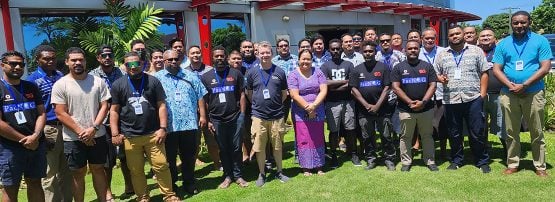
As outlined in the 2025 Activity Plan, the APNIC Blog will feature an ongoing series of posts highlighting economies across the Asia Pacific region. These articles, available via the ‘Economy Report‘ tag, will explore each economy’s Internet infrastructure, along with their challenges and achievements in capacity development, security, resilience, and community building. Bangladesh was first in the series. In this post, we’ll look at Fiji.
Fiji, located in Melanesia in the South Pacific, is an archipelago of over 330 islands and home to approximately 929,000 people, 87% of whom reside on the two main islands, Viti Levu and Vanua Levu. While internationally celebrated for its natural beauty and cultural richness, Fiji is also gaining recognition as a digital leader in the Pacific.
The launch of Fiji’s National Digital Strategy (NDS) in April 2025 marked a major milestone in its digital transformation. Designed around five key pillars — Digital Infrastructure and Cyber Resilience, Digital Inclusion and Empowerment, Innovation-Led Economic Growth, Smart Governance and Digital Public Services, and Sustainable Development and Global Collaboration — the NDS aims to expand connectivity, strengthen cybersecurity, modernize public services, and improve digital literacy. By leveraging strategic investments in infrastructure, policy, and fostering global collaboration, Fiji is positioning itself to thrive in the global digital economy and build long-term resilience for its infrastructure.
Connectivity
As of 2023, the ITU reports that approximately 79.3% of Fiji’s population are Internet users, an impressive rise from just 48% in 2018. This growth has been driven largely by mobile broadband, which remains the dominant mode of access due to the economy’s dispersed geography and the limited reach of fixed-line infrastructure. While urban centres such as Suva and Nadi benefit from high-speed connectivity, extending reliable Internet services to rural and remote communities remains a key challenge.
The introduction of satellite services has helped bridge these gaps by providing high-speed connectivity across the islands, including remote communities. These services have also increased market competition, driving improvements in access and pricing. However, affordability remains a significant barrier, especially for low-income households. Addressing these issues is critical to achieving inclusive digital access and unlocking the full potential of Fiji’s digital economy.
Fiji Internet infrastructure
Internet Exchange Points (IXPs)
The establishment of the Fiji Internet Exchange Point (Fiji-IX) in 2017 significantly improved local Internet traffic routing. Initially launched with four ISPs, Fiji-IX now includes seven members, including major providers like Vodafone Fiji, Digicel Fiji, and Telecom Fiji.
APNIC played a role in the initial deployment of Fiji-IX by providing technical support and hardware, and continues to offer capacity building and infrastructure upgrades. Discussions are also underway to deploy an M-Root server in Fiji, which would further enhance regional DNS resilience.
Fiji-IX has greatly reduced local latency, improved service quality, and lowered ISP operating costs, while encouraging the growth of locally hosted services.
Submarine cable
Fiji’s strategic location has made it a hub for submarine cable networks. The economy is connected through the Southern Cross Cable Network and the Southern Cross NEXT, providing high-capacity links to international networks. Additionally, the Interchange Cable Network connects Fiji to Vanuatu, Gondwana-2/Picot-2 connects Fiji to New Caledonia, Tui-Samoa connects Fiji to Samoa and Wallis and Futuna, and the Tonga Cable System links Fiji to Tonga.
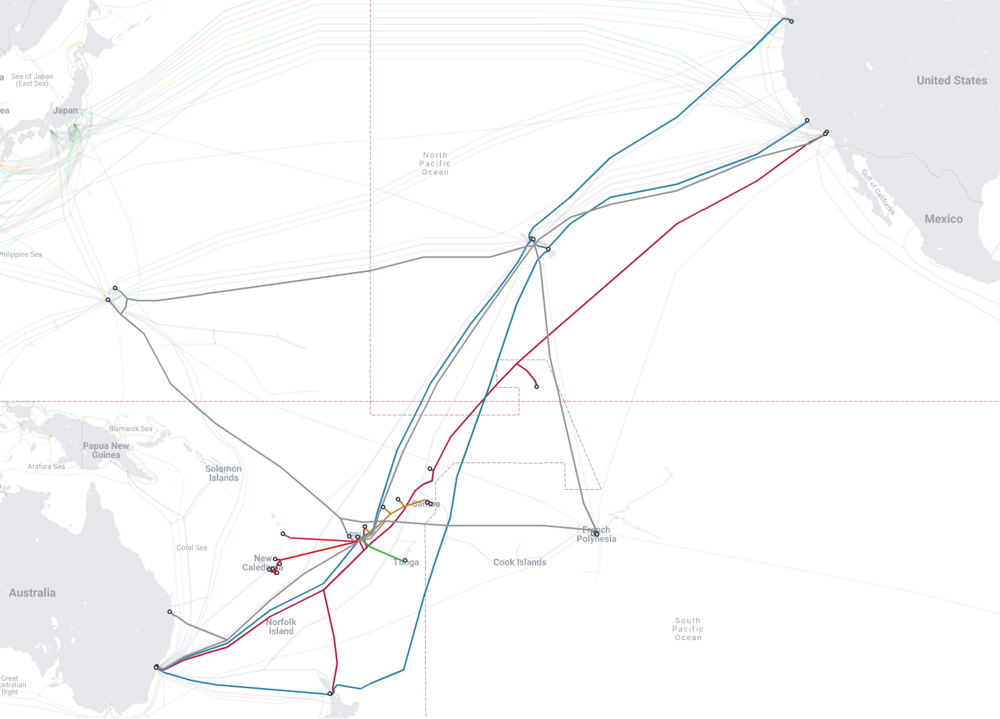
To improve digital resilience, the Fijian government has partnered with Google for the Pacific Connect initiative to develop the Bulikula and Tabua subsea cables, connecting Fiji to the United States, Australia, Japan, and South America. It landed in January 2025 and is expected to be operational in 2026 and includes the construction of a second cable landing station and a Tier 3 Data Centre in Fiji. These developments mark significant progress in Fiji’s digital infrastructure, enhancing its role in global data connectivity and are estimated to contribute USD 250 million to Fiji’s GDP by 2030 and create over 3,600 jobs across various sectors.
Data centres and Content Delivery Networks (CDNs)
Fiji’s data centre infrastructure is expanding to support its growing digital economy and regional connectivity. Key facilities currently in operation include FINTEL’s data centre in Vatuwaqa, the Government ITC Centre, Telecom Fiji, Centrecom, and Datec Fiji. These provide secure hosting, cloud services, and disaster recovery for the public and private sectors. Fiji also hosts major CDNs, including Google, Meta, Netflix, and Cloudflare, which cache content locally and reduce international bandwidth demand.
Currently, 41% of the top 1,000 websites in Fiji are served from local caches, which is higher than many other Pacific Island economies but still below the Oceania average of 59%. Expanding local content hosting and CDN presence is key to reducing latency and improving user experience.
IPv6 and RPKI deployment
IPv6
As of June 2025, Fiji’s IPv6 capability rate stands at approximately 35%, indicating moderate progress compared to other Pacific Island economies while still sitting slightly below the Oceania regional average of 39.89% (Figure 2).
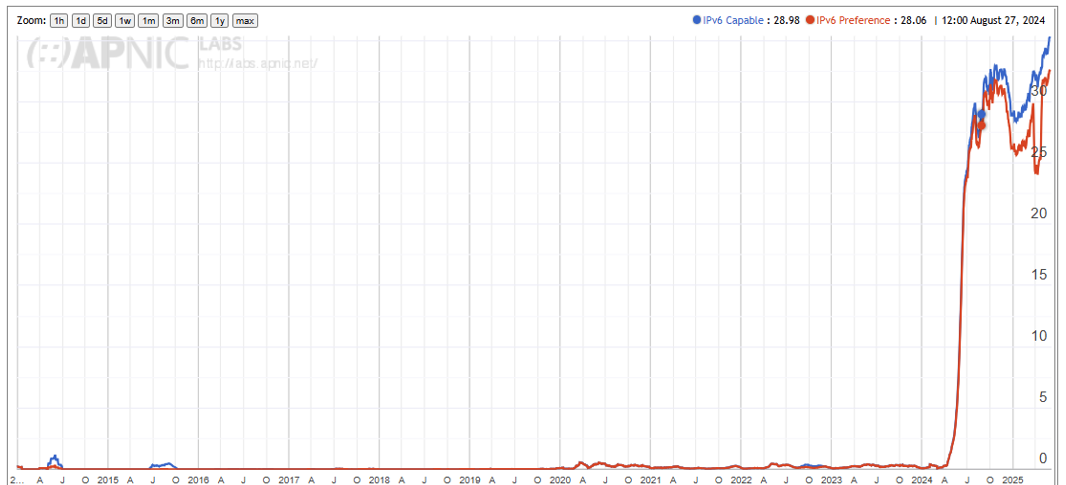
The rapid growth of Fiji’s IPv6 capability, shown in Figure 2, was largely driven by Vodafone Fiji exhausting its IPv4 resources and Starlink entering the market. However, several barriers delay broader IPv6 deployment, including a shortage of skilled network engineers, limited awareness of IPv6 benefits, high costs associated with upgrading legacy infrastructure, and a lack of demand.
RPKI
RPKI deployment (Figure 3) in Fiji is strong in terms of Route Origin Authorization (ROA) coverage, with APNIC Labs showing 99% of prefixes are now ROA protected. However, Route Origin Validation (ROV), the practice of rejecting invalid route announcements, remains underused (Figure 4), with an average of 35% (during the last 30 days) of routes actively validated and just a few networks implementing ROV in practice.
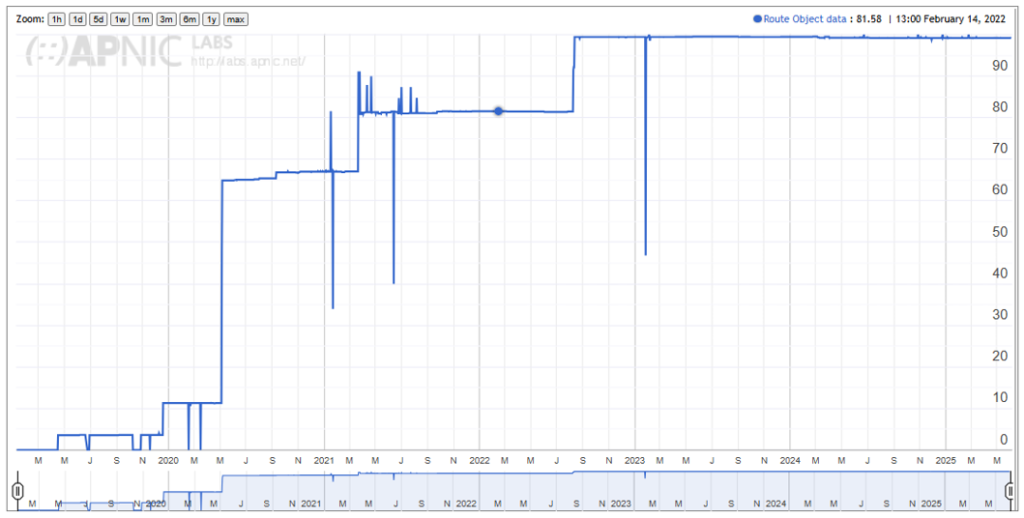
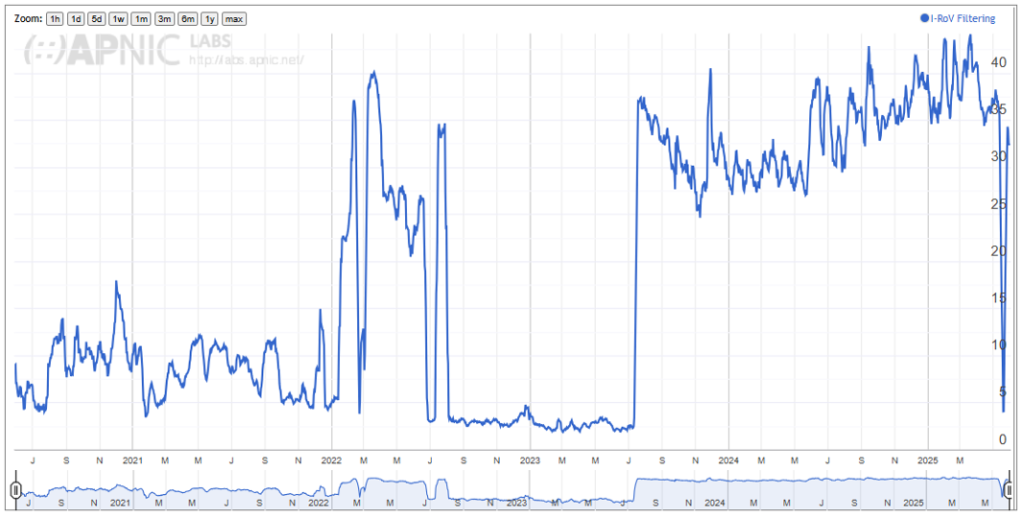
ROV adoption remains moderate because many network operators are cautiously concerned that misconfigurations could disrupt traffic. This hesitation is compounded by limited technical expertise and the lack of regulatory incentives or mandates to implement filtering more widely.
Internet security
As Fiji’s connectivity and digital services grow, Internet security has become an increasingly important priority. Establishment of a national Computer Emergency Response Team (CERT) is underway, and there has been significant engagement with stakeholders to enhance incident response capabilities.
APNIC is playing a role in supporting these efforts, working alongside partners such as FIRST, the Pacific Cyber Security Operational Network (PaCSON), and the Pacific Network Operators Group (PacNOG). In 2019, APNIC supported the FIRST Regional Symposium in Nadi, and in 2023, contributed to the National Critical Infrastructure Cybersecurity Workshop in Suva, bringing together experts to build local capacity and strengthen critical infrastructure protections.
Fiji faces cybersecurity challenges common in the region, such as skills shortages, limited resources, and slow adoption of best practices. Despite these hurdles, momentum is growing as various stakeholders work together to improve national cybersecurity resilience.
The APNIC Foundation continues to support cybersecurity across the Pacific through strategic initiatives and partnerships. Projects such as ‘A Secure and Resilient Internet Infrastructure‘ strengthened Internet security by supporting the development of CERTs, while the Safe Silver Surfers initiative promotes digital safety for older users. Collaboration with the Australian Federal Police through the Cyber Safety Pasifika program builds capacity for local law enforcement, digital forensics and public safety across the Pacific region.
Internet community
Fiji actively leads and participates in the Pacific’s Internet community through regional forums like the Pacific Islands Telecommunications Association (PITA), PacNOG, and the Pacific Internet Governance Forum (PacIGF), which provide essential platforms for knowledge sharing, technical training and policy discussions.
As regular hosts of events such as the PITA AGM and Business Expo and PacNOG workshops and conferences, including the upcoming PacNOG 35 in Suva later this month, the Fiji Internet community benefits from increased opportunities for regional collaboration, hands-on technical training, knowledge exchange, and direct engagement with global experts.
Additionally, through programs like PacTraining, an APNIC Foundation project funded by DFAT, APNIC delivered specialized training to enhance cybersecurity knowledge and technical skills among Pacific network operators.
Despite progress, several challenges persist. There is a shortage of skilled workers, limited funding, and difficulty retaining Information and Communication Technology (ICT) talent, as local professionals leave in search of other opportunities. The remaining local technical community is small, so individuals often handle multiple roles, which limits their ability to specialize. Fiji’s wide geographical spread and the lack of regular national forums also make it hard for stakeholders to network, coordinate, and share knowledge consistently.
Fiji’s NDS aims to address these issues, emphasizing workforce development, digital inclusion, and strategic partnerships. It promotes investment in ICT education and professional growth while supporting national and regional CERT efforts to bolster cyber resilience.
The road ahead
Fiji stands at a pivotal point in its digital journey, with strong foundations and a clear vision outlined in its NDS. Sustained progress depends on the active collaboration of all stakeholders, including government, the private sector, the technical community, academia, and civil society. Beyond technical training, initiatives including mentoring and career development are important to ensure the next generation of Internet leaders is nurtured and retained within their communities.
By aligning regulatory frameworks with infrastructure development and capacity-building efforts, Fiji can build a more resilient digital ecosystem that empowers communities, strengthens regional leadership, and secures long-term social and economic benefits.
The views expressed by the authors of this blog are their own and do not necessarily reflect the views of APNIC. Please note a Code of Conduct applies to this blog.
